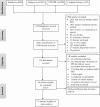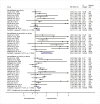Improving socioeconomic status may reduce the burden of malaria in sub Saharan Africa: A systematic review and meta-analysis
- PMID: 30677102
- PMCID: PMC6345497
- DOI: 10.1371/journal.pone.0211205
Improving socioeconomic status may reduce the burden of malaria in sub Saharan Africa: A systematic review and meta-analysis
Abstract
Background: A clear understanding of the effects of housing structure, education, occupation, income, and wealth on malaria can help to better design socioeconomic interventions to control the disease. This literature review summarizes the relationship of housing structure, educational level, occupation, income, and wealth with the epidemiology of malaria in sub-Saharan Africa (SSA).
Methods: A systematic review and meta-analysis was conducted following the preferred reporting items for systematic reviews and meta-analyses guidelines. The protocol for this study is registered in PROSPERO (ID=CRD42017056070), an international database of prospectively registered systematic reviews. On January 16, 2016, available literature was searched in PubMed, Embase, CINAHL, and Cochrane Library. All but case studies, which reported prevalence or incidence of Plasmodium infection stratified by socioeconomic status among individuals living in SSA, were included without any limits. Odds Ratio (OR) and Relative Risk (RR), together with 95% CI and p-values were used as effect measures. Heterogeneity was assessed using chi-square, Moran's I2, and tau2 tests. Fixed (I2<30%), random (I2≥30%) or log-linear dose-response model was used to estimate the summary OR or RR.
Results: After removing duplicates and screening of titles, abstracts, and full text, 84 articles were found eligible for systematic review, and 75 of them were included in the meta-analyses. Fifty-seven studies were cross-sectional, 12 were prospective cohort, 10 were case-control, and five were randomized control trials. The odds of Plasmodium infection increased among individuals who were living in poor quality houses (OR 2.13, 95% CI 1.56-3.23, I2 = 27.7), were uneducated (OR 1.36, 95% CI 1.19-1.54, I2 = 72.4.0%), and were farmers by occupation (OR 1.48, 95% CI 1.11-1.85, I2 = 0.0%) [p<0.01 for all]. The odds of Plasmodium infection also increased with a decrease in the income (OR 1.02, 95% CI 1.01-1.03, tau2<0.001), and wealth index of individuals (OR 1.25, 95% CI 1.18-1.35, tau2 = 0.028) [p<0.001 for both]. Longitudinal studies also showed an increased risk of Plasmodium infection among individuals who were living in poor quality houses (RR 1.86, 95% CI 1.47-2.25, I2 = 0.0%), were uneducated (OR 1.27, 1.03-1.50, I2 = 0.0%), and were farmers (OR 1.36, 1.18-1.58) [p<0.01 for all].
Conclusions: Lack of education, low income, low wealth, living in poorly constructed houses, and having an occupation in farming may increase risk of Plasmodium infection among people in SSA. Public policy measures that can reduce inequity in health coverage, as well as improve economic and educational opportunities for the poor, will help in reducing the burden of malaria in SSA.
Conflict of interest statement
The authors have declared that no competing interests exist.
Figures






Similar articles
-
A systematic review and meta-analysis of asymptomatic malaria infection in pregnant women in Sub-Saharan Africa: A challenge for malaria elimination efforts.PLoS One. 2021 Apr 1;16(4):e0248245. doi: 10.1371/journal.pone.0248245. eCollection 2021. PLoS One. 2021. PMID: 33793584 Free PMC article.
-
Preventive malaria treatment among school-aged children in sub-Saharan Africa: a systematic review and meta-analyses.Lancet Glob Health. 2020 Dec;8(12):e1499-e1511. doi: 10.1016/S2214-109X(20)30325-9. Epub 2020 Oct 22. Lancet Glob Health. 2020. PMID: 33222799 Free PMC article.
-
Malaria and helminth co-infections in children living in endemic countries: A systematic review with meta-analysis.PLoS Negl Trop Dis. 2021 Feb 18;15(2):e0009138. doi: 10.1371/journal.pntd.0009138. eCollection 2021 Feb. PLoS Negl Trop Dis. 2021. PMID: 33600494 Free PMC article.
-
Housing and child health in sub-Saharan Africa: A cross-sectional analysis.PLoS Med. 2020 Mar 23;17(3):e1003055. doi: 10.1371/journal.pmed.1003055. eCollection 2020 Mar. PLoS Med. 2020. PMID: 32203504 Free PMC article.
-
Housing Improvements and Malaria Risk in Sub-Saharan Africa: A Multi-Country Analysis of Survey Data.PLoS Med. 2017 Feb 21;14(2):e1002234. doi: 10.1371/journal.pmed.1002234. eCollection 2017 Feb. PLoS Med. 2017. PMID: 28222094 Free PMC article.
Cited by
-
Impacts of Deforestation on Childhood Malaria Depend on Wealth and Vector Biology.Geohealth. 2024 Feb 28;8(3):e2022GH000764. doi: 10.1029/2022GH000764. eCollection 2024 Mar. Geohealth. 2024. PMID: 38425366 Free PMC article.
-
Perceptions and behaviors of healthcare providers towards rehabilitation support to children with severe malaria-related disability in Ethiopia: A qualitative descriptive study using the Theoretical Domains Framework.PLoS One. 2024 May 2;19(5):e0298769. doi: 10.1371/journal.pone.0298769. eCollection 2024. PLoS One. 2024. PMID: 38696368 Free PMC article.
-
Factors Associated with Malaria Preventive Measures among Pregnant Women in Guinea.Infect Dis Obstet Gynecol. 2021 Jul 1;2021:9914424. doi: 10.1155/2021/9914424. eCollection 2021. Infect Dis Obstet Gynecol. 2021. PMID: 34305392 Free PMC article.
-
New highly antigenic linear B cell epitope peptides from PvAMA-1 as potential vaccine candidates.PLoS One. 2021 Nov 2;16(11):e0258637. doi: 10.1371/journal.pone.0258637. eCollection 2021. PLoS One. 2021. PMID: 34727117 Free PMC article.
-
Prevalence and drivers of malaria infection among asymptomatic and symptomatic community members in five regions with varying transmission intensity in mainland Tanzania.Parasit Vectors. 2025 Jan 24;18(1):24. doi: 10.1186/s13071-024-06639-1. Parasit Vectors. 2025. PMID: 39856695 Free PMC article.
References
-
- World malaria report 2015. Available from: http://apps.who.int/iris/bitstream/10665/200018/1/9789241565158_eng.pdf. [Accessed February 6, 2017]
-
- WHO. Malaria. http://www.who.int/mediacentre/factsheets/fs094/en/. [Accessed January 5 2018].
Publication types
MeSH terms
LinkOut - more resources
Full Text Sources
Medical
Research Materials

